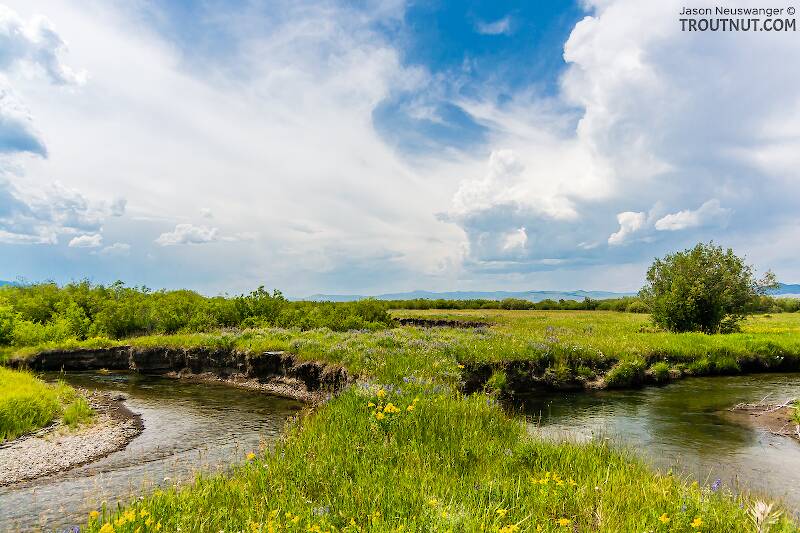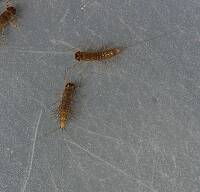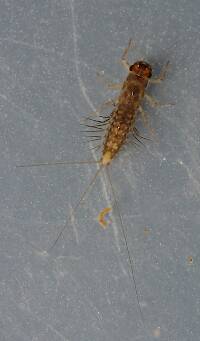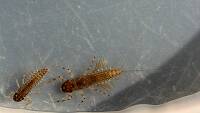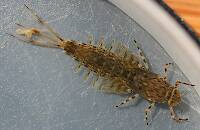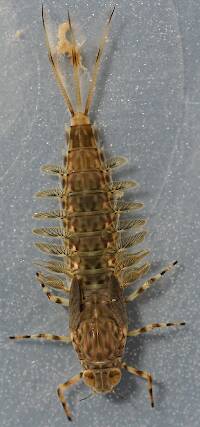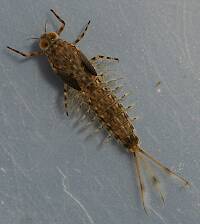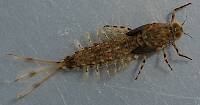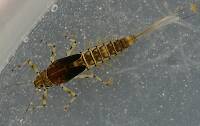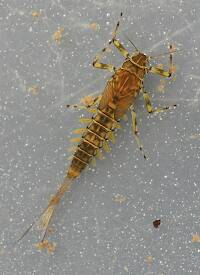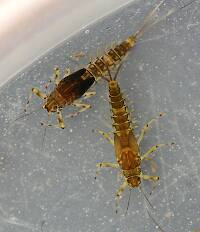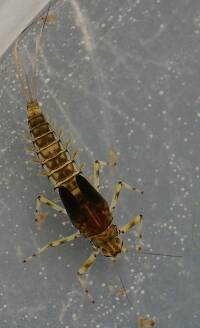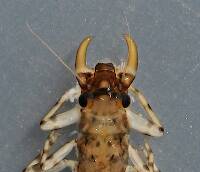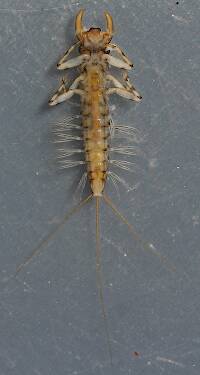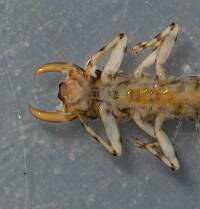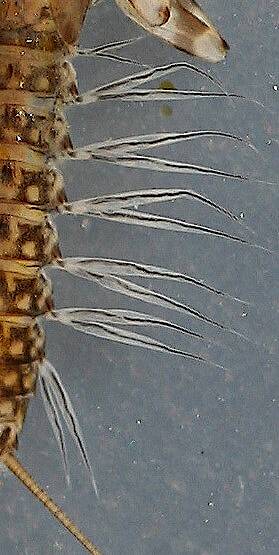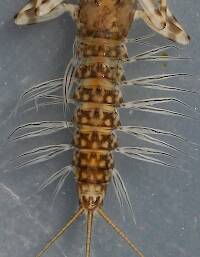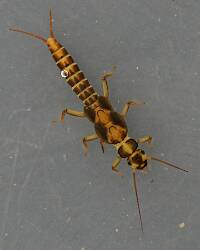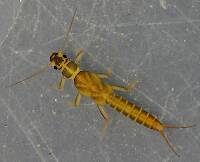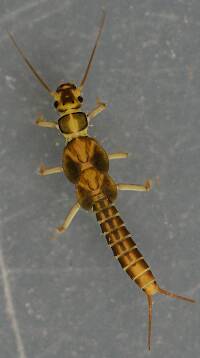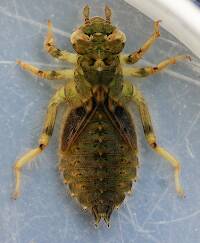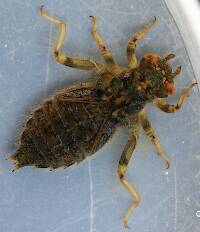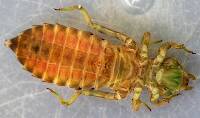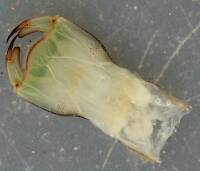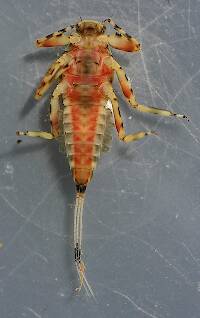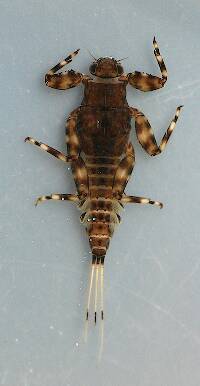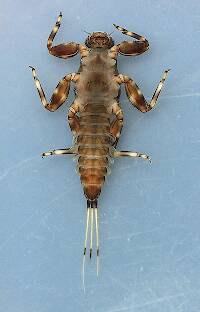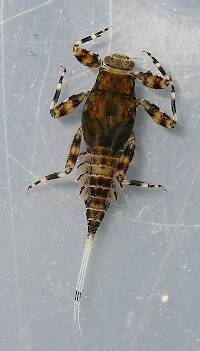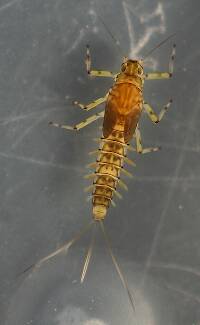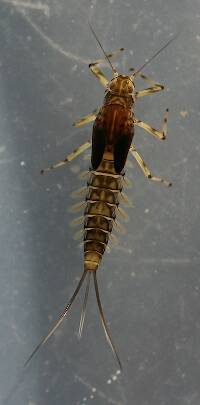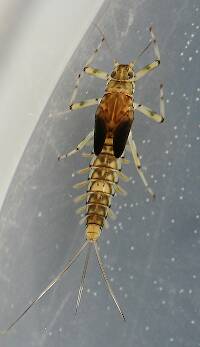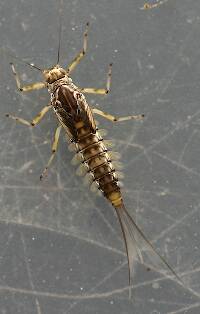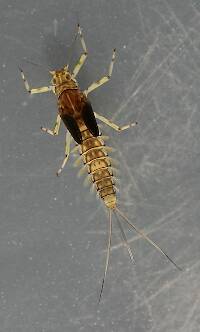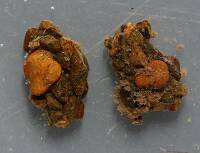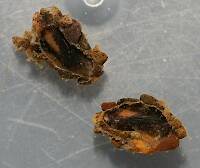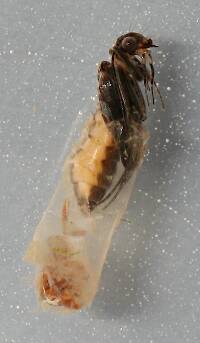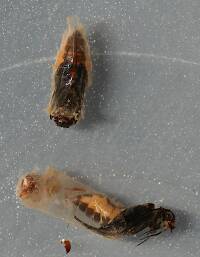
Blue-winged Olives
Baetis
Tiny Baetis mayflies are perhaps the most commonly encountered and imitated by anglers on all American trout streams due to their great abundance, widespread distribution, and trout-friendly emergence habits.
Featured on the forum

This one was surprisingly straightforward to identify. The lack of a sclerite at the base of the lateral hump narrows the field quite a bit, and the other options followed fairly obvious characteristics to Clostoeca, which only has one species, Clostoeca disjuncta.

Troutnut is a project started in 2003 by salmonid ecologist Jason "Troutnut" Neuswanger to help anglers and
fly tyers unabashedly embrace the entomological side of the sport. Learn more about Troutnut or
support the project for an enhanced experience here.
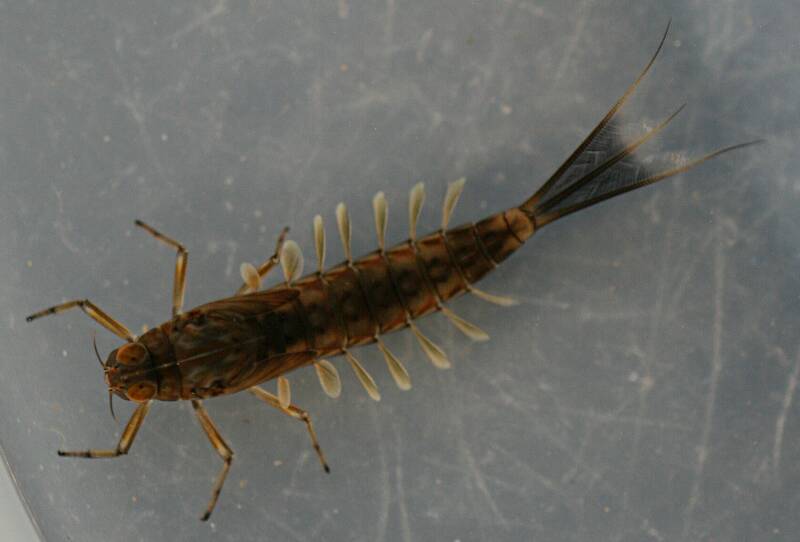
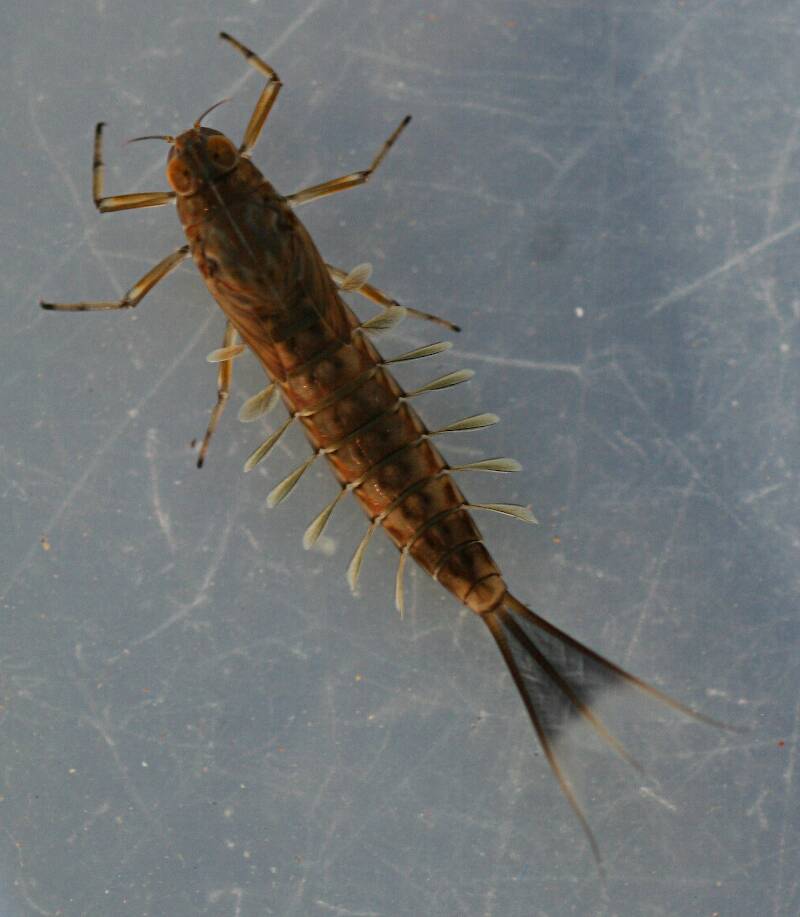
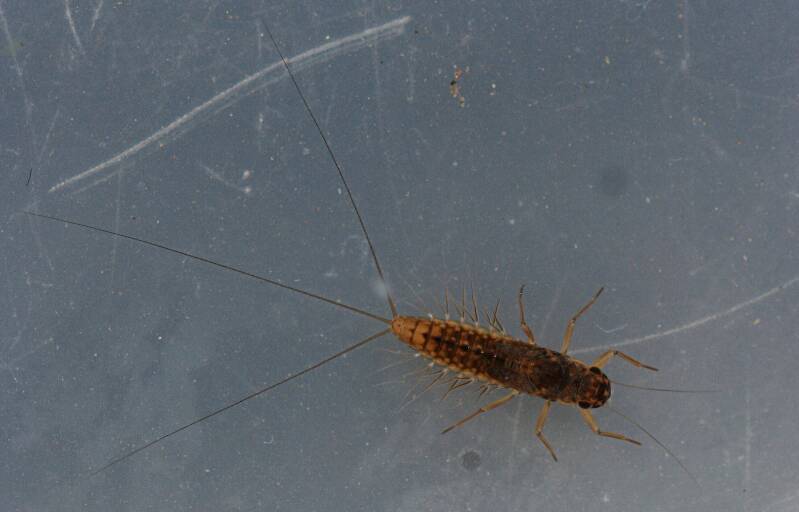
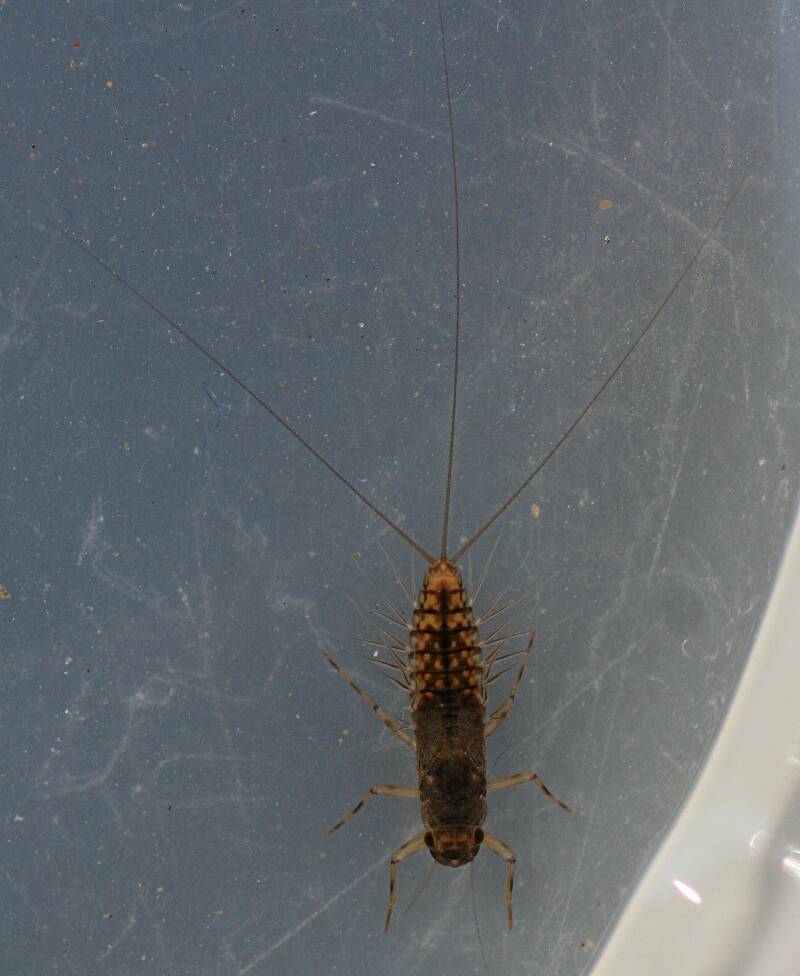
Millcreek on Feb 29, 2016February 29th, 2016, 2:14 pm EST
Found these today while looking at a small first order stream that feeds into the Russian River. The stream is quite small (you can step over it without a problem) and very cold. It feeds through some redwoods and originates underground.
The first is the Ameletus. I think it's Ameletus celer. At least that's what it keys out to in "Larvae and adults of Ameletus mayflies (Ephemeroptera: Ameletidae) from Alberta" by Zloty and Pritchard. It's 11 mm in length excluding the cerci.
The second is a Paraleptophlebia. After that it's anybody's guess as to what species it is since there's no key to western species for nymphs. It's 6 mm in length excluding the cerci.
I haven't found either of these species in the Russian River yet.
The first is the Ameletus. I think it's Ameletus celer. At least that's what it keys out to in "Larvae and adults of Ameletus mayflies (Ephemeroptera: Ameletidae) from Alberta" by Zloty and Pritchard. It's 11 mm in length excluding the cerci.
The second is a Paraleptophlebia. After that it's anybody's guess as to what species it is since there's no key to western species for nymphs. It's 6 mm in length excluding the cerci.
I haven't found either of these species in the Russian River yet.
"If we knew what it was we were doing, it would not be called research, would it?"
-Albert Einstein
-Albert Einstein
PaulRoberts on Mar 1, 2016March 1st, 2016, 8:57 am EST
Sounds like Ameletus water to me!
Millcreek on Mar 1, 2016March 1st, 2016, 1:33 pm EST
Paul - More like Paraleptophlebia water. They outnumber the Ameletus about ten to one. It's an interesting piece of water. Haven't been able to access the water on the bottom third but the center third where the water goes through the redwoods has mostly Paraleptophlebia with an occasional Chloroperlid and Ameletid. The top third has mostly Ameletus with very young Paraleptophlebia.
"If we knew what it was we were doing, it would not be called research, would it?"
-Albert Einstein
-Albert Einstein
PaulRoberts on Mar 2, 2016March 2nd, 2016, 8:35 am EST
Moderate current? (I knew the eastern P. adoptiva, and that is all.)
Ameletus are up in the headwaters where they seem especially to like to cling under overhangs. Further down they seem relegated to cascades.
Hey, an image of the habitats of your collections would be neat,
Ameletus are up in the headwaters where they seem especially to like to cling under overhangs. Further down they seem relegated to cascades.
Hey, an image of the habitats of your collections would be neat,
Millcreek on Mar 2, 2016March 2nd, 2016, 12:15 pm EST
The Paraleptophlebia were taken in areas of nearly no current, the bottoms of small pools and the edges of the pools.
The Ameletus were in areas of faster current, though not very fast. They tended to be on the edges of riffles.
So far I've only got pictures of the Russian River. I'll try and add a few others. The one of the Russian River is here. http://www.troutnut.com/topic/8675/Epeorus-sp-longimanus#toppost
You'll have to scroll to the top to find it.
The Ameletus were in areas of faster current, though not very fast. They tended to be on the edges of riffles.
So far I've only got pictures of the Russian River. I'll try and add a few others. The one of the Russian River is here. http://www.troutnut.com/topic/8675/Epeorus-sp-longimanus#toppost
You'll have to scroll to the top to find it.
"If we knew what it was we were doing, it would not be called research, would it?"
-Albert Einstein
-Albert Einstein
Minnowbait on Mar 3, 2016March 3rd, 2016, 6:39 am EST
I'd like to start photographing macroinvertebrates. I have a very basic microscope with a small field of vision. Can anyone recommend a good scope? I have a camera that can be inserted into a triocular port or into one of the eyepieces already.
minnowbait
Millcreek on Mar 3, 2016March 3rd, 2016, 8:40 am EST
Lynn-
I'd forget about the scope and invest in a good SLR and lens. I use a Canon Rebel and either a 50 or 100 mm macro lens. It'll cost you some money but it'll be worth it if you're serious about photographing macros.
Scopes are good for IDs on macroinvertebrates. Hell, they're damn near indispensable for that. But unless you need pictures of small parts of the anatomy I can't really see it.
EDIT- You'll also need a small tripod.
I'd forget about the scope and invest in a good SLR and lens. I use a Canon Rebel and either a 50 or 100 mm macro lens. It'll cost you some money but it'll be worth it if you're serious about photographing macros.
Scopes are good for IDs on macroinvertebrates. Hell, they're damn near indispensable for that. But unless you need pictures of small parts of the anatomy I can't really see it.
EDIT- You'll also need a small tripod.
"If we knew what it was we were doing, it would not be called research, would it?"
-Albert Einstein
-Albert Einstein
Creno on Mar 3, 2016March 3rd, 2016, 6:48 pm EST
I would agree with Millcreek. Get a good DSLR and macro. And the Canon rebel is a good choice as it comes with great software to connect to the PC if ya want. I have two of them connected to microscopes for details. But, as you can see from Millcreeks pics, the Rebel and macro is wonderful for larger specimens.
EDIT - I should have started with - there are no wide fields with a microscope. The goal of the microscope is to get close to small parts. While the microscope is good at seeing small parts, the tradeoff is depth of field (DOF) and width of field (WOF). The more magnification the less DOF and WOF.
EDIT - I should have started with - there are no wide fields with a microscope. The goal of the microscope is to get close to small parts. While the microscope is good at seeing small parts, the tradeoff is depth of field (DOF) and width of field (WOF). The more magnification the less DOF and WOF.
Hansolo
Posts: 2
Posts: 2
Hansolo on Jun 4, 2016June 4th, 2016, 10:34 am EDT
I used to fish the paraleps hatches in CT in early spring. Total black nymphs. Skinny, ruffled, beautiful. I would say the water temp was 35 degrees. No more than 40. Ice-on-the-water type fishing.
Does anyone have pictures of the adult versions of all these nymphs? Thanks.
Does anyone have pictures of the adult versions of all these nymphs? Thanks.
Quick Reply
Related Discussions
Topic
Replies
Last Reply
9
Jul 22, 2014
by Crepuscular
by Crepuscular

